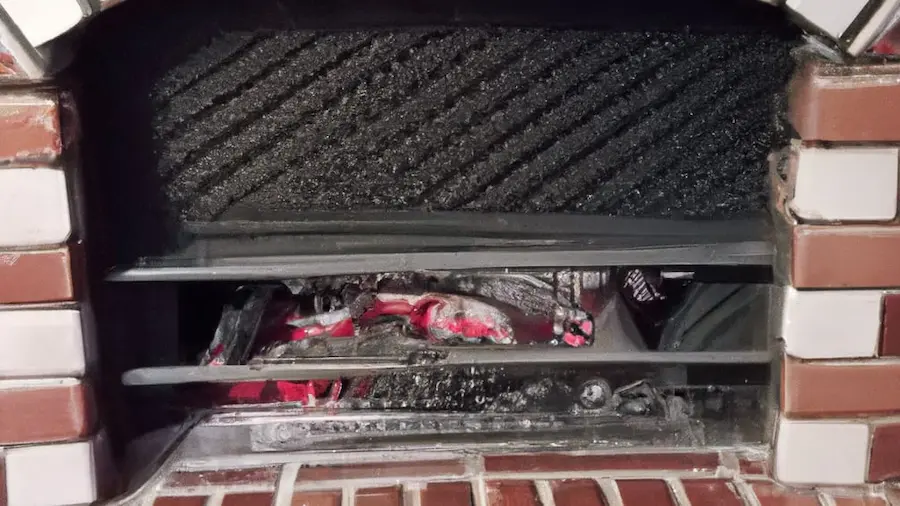~ 6 min read
How to Tile Over a Brick Fireplace (and Make It Work!)

Although it might seem like a no-brainer to cover a brick fireplace with more brick, it requires a bit of extra work to make it look good. Brick tile is a durable option, but it can be expensive and requires some special considerations to ensure it lasts.
Why tile over a brick fireplace?
Brick is one of the most common building materials but can be a complex surface to work with because it is uneven, porous, and has sharp edges. If you have a brick fireplace, you may wonder if there is a way to make it work or if you should focus on tiling the walls. The answer depends on the brick surface’s size and quality.
The rough, uneven surface can be difficult to tile over a brick fireplace. If you remove the mortar, you won’t have a smooth surface to lay the tile. Preparing the surface, so it is smooth enough for tiling takes time and effort. You have to remove all of the mortar, grind down the brick surface, and add a new layer of mortar to create a smooth surface. This is challenging and time-consuming.
It is much easier to tile over a brick fireplace with a smooth surface. Many fireplaces have bricks installed without any mortar in between the bricks. While this makes for a rough surface, each brick is still smooth. You can tile right over these bricks, creating a smooth surface that is easier to work with than brick that is installed with mortar.
What to consider when tiling over a brick fireplace
Fireplaces can be tricky to tile because they create a row of tiles that sits directly on the brick surface. It isn’t always easy to get the right fit and spacing, especially if the tiles are going to be perfectly straight.
You can make it work with care. First, ensure two rows of tiles sit on top of the brick surface. The first row should be ceramic, and the second row should be marble. The ceramic tiles will be easier to install.
Measure the brick surface carefully and then calculate the number and size of ceramic tiles you need. You will probably have to buy a few extra, but you can return any unnecessary items.
Cut the ceramic tiles to fit, ensuring the grout joints are even and regular. Row them up straight and then remove them. You should now have a row of ceramic tiles on top of the brick surface.
Now place the marble tiles. The size and spacing of these will be much trickier, but you should still be able to get a good fit. If it isn’t perfect, make adjustments after the grout has dried.
How to tile over a brick fireplace – step by step
Even the most carefully laid tile will not sit flush with a brick fireplace surround. The bricks will be just a little uneven, and even worse, the mortar will be full of holes and voids. This makes it impossible to get a smooth, flat surface for the tiles.
There is a solution, though, that does not involve installing new tile wider than the brick. The answer is to use grout that is almost, but not too, thick.
First, coat the brick with a thin layer of grout. You should use a grout float to spread evenly, just like a tiled surface. Let this harden.
Next, use an almost dry grout float. If the surface feels smooth, move on to the next step. But if it still feels grainy, add a little more water to the grout and re-wet the surface.
You should end up with a thin coating of smooth, hard grout that is almost but not too thick to fill the gaps between the bricks.
Now you can move on to the next step – adding grout to fill the gaps between the bricks.
How to make tiling over a brick fireplace work
The brick veneer on a brick fireplace can challenge tiling, but the task is not impossible. The key is to create a wide space for your tile to fit between bricks with no extra grout in the spaces (because excess grout will show).
One good way to ensure your tile spacers are in the right place is to create a herringbone pattern with the first row of your tiles. You can create a herringbone pattern by alternating the direction in that you offset each tile by half a tile width from the row below. This means that each tile in the row will be offset either to the left or to the right by half a tile width from the rows below, creating a zigzagging pattern.
Begin the herringbone pattern at the bottom of the wall with a tile centered on a brick. Then, offset the next tile to the right and the next tile to the left. Each tile in the row will be compensated the same amount as the rows below. You will continue offsetting the tiles but alternate the direction in which you are canceling the tiles from row to row. This pattern will create a herringbone pattern of rows of tiles.
The key to this pattern is that each tile in the row will be offset the same amount as the rows below, so you will not have any extra grout in the spaces between the bricks. You can use this pattern to ensure that you have the ideal tile spacers for your project.
If you’re looking for a way to update your brick fireplace, tiling over it is a great option! With careful planning and execution, you can successfully tile over your brick fireplace and make it work with your home’s décor. Keep these tips in mind, and you’ll surely achieve the look you’re going for.
Related Reading: